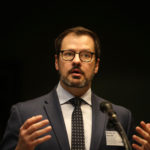The real challenge of innovation
True innovation rarely comes from the mind of one person or in one blinding flash. Graham Thorburn says for innovation to work, everyone must be prepared to put their ideas on the table, be prepared to listen and to hear other people’s ideas.
After a distinguished career directing film and television in the UK, John Schlesinger’s first studio film in the US was Midnight Cowboy, and he chose to work with the talented and vastly experienced Joseph Heller as producer. The industry aphorism is ‘get the script and casting right, and you’re 90% of the way there’, and Schlesinger and Heller put a lot of work into getting those right.
Finally they agreed on all the key cast and handed the production secretary the paperwork to type up and send out the letters of offer. Heller recalls standing around feeling very pleased with himself, when a small voice behind him spoke up. ‘Excuse me Mr Heller. I know this isn’t my job, but I just need to check. You want to offer him [holding up a headshot of Warren Beatty] the part of the guy who goes to New York to become a gigolo, and fails?’
And I think she was right. More to the point, Heller and Schlesinger agreed that she was right. They cast John Voigt instead, and the rest is history.
There are three crucial things about this story. The first is that the secretary cared enough and felt connected enough to have an opinion. The second is that she felt able to speak up, despite her lowly position in the hierarchy (and films are very hierarchical). And finally, Heller not only listened, but heard.
True innovation rarely comes from the mind of one person, and rarely comes in one blinding flash. Most innovation comes from a group of people with different characters and different discipline sets working together to incrementally solve problems step-by-step. And yet each moment of insight comes to a single individual, but cannot be tested until it is shared with the group. This is the real challenge of innovation.
At each hiatus the crucial insight can come from anybody – as long as they are connected, informed, and heard. Everybody ‘in the room’ must be prepared to put their ideas on the table, and also must be prepared to listen and hear other people’s ideas.
But it’s much easier for the group to kill new ideas than to nurture them, especially if they threaten your power. Which can apply equally at the top (‘To support my ego I must be able to claim ownership of every good idea that comes from this group’) or the bottom (‘Why should I change all my systems to suit his fantasy?’). Ideas must be given the space to grow.
On the other hand, a chain of perfectly reasonable insights can lead to a cul-de-sac, and the longer the chain the harder it is to recognise that it’s a cul-de-sac. This contradiction often plays out during the development of a screenplay. When an inexperienced writer’s first draft hits the inevitable hurdles, they often find it much easier to start with a new idea than work their way through the problem, so they are constantly writing new first drafts. Experienced writers know that real writing is rewriting, and they know that things often get worse before they get better again. The trap they face is not knowing the difference between doing one more draft and writing yourself into a corner.
It’s complex for an individual, and complexity increases exponentially with the number of people, the number of different disciplines, and the number of steps required to reach a viable outcome.
In complex systems where you are trying to maximise the creative input across the whole group but at the same time maintain a coherent and unified vision, power, status and leadership play a crucial part. The necessary unity can be achieved through a commitment to a common purpose, or a commitment to a leader. History tells us that human beings find it easier to commit to a leader than a purpose, which makes it incumbent on the leader to constantly take the group back to the common purpose. Somehow the best leaders manage to reconcile strong leadership and structures with egalitarianism, and this is not easy to do.
But most of all, it’s crucial to respect the subconscious. There are two kinds of collaboration going on here: collaboration between conscious rational processes and unconscious imaginary processes; and collaboration between individuals who have different personal status, different individual styles, different information, and different skill sets.
Fortunately there are conscious processes that can be applied to managing both kinds of collaboration. Of which, more next week.
After graduating as an electronic engineer, Graham Thorburn moved into the arts, where he has had a typically peripatetic career ranging from acting (film, TV and theatre); directing and occasionally writing and producing (more than 70 hours of prime time TV); an academic; and a senior manager at Australia’s national Film and TV school AFTRS. He has a sideline editing novels.














